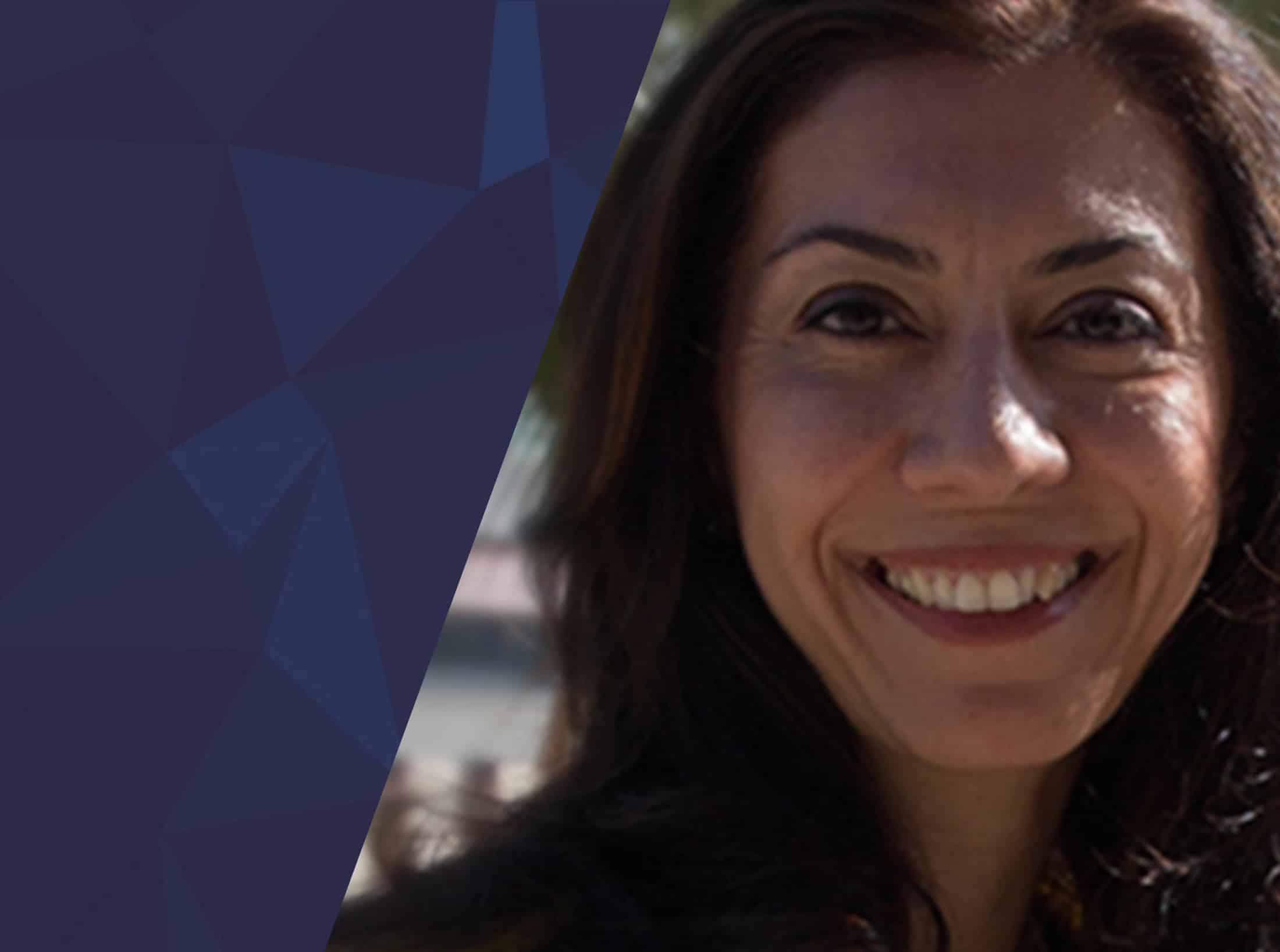The Department of Civil and Environmental Engineering recently launched our new Strategic Directions website, detailing the five principles guiding our vision of the future of pedagogy, research and service. The Building the Future Distinguished Lecture Series provides a forum to discuss each strategic theme and build a broad community that includes industry professionals, researchers, educators, and students. In the fourth installment, Director of Urban Water Policy at Stanford University Newsha Ajami delivered a lecture on the need to build a diverse financing portfolio and novel governance tools to support the sector’s shifting paradigm as it transitions from a centralized model to a 21st century hybrid model, encompassing both centralized and decentralized solutions.
After the lecture, U-M Civil and Environmental Engineering Professor Peter Adriaens moderated a discussion between Ajami, Jon Allan (Academic and Research Program Officer Sr., School for Environment and Sustainability, University of Michigan), Eric Letsinger (CEO, Quantified Ventures) and Sanjiv Sinha (Senior Vice President, Environmental Consulting & Technology, Inc. (ECT)).
The panelists discussed using data to map changing water use and future (and current) data markets. What follows is an excerpt of their discussion, which has been shortened for clarity. The entire lecture and panel discussion can be found here, along with the rest of the lectures in the series.
***
Eric Letsinger: “I think all this data that Newsha just talked about and all the smart infrastructure that’s producing a lot of the data is just creating phenomenal opportunities for the public sector to pay for things in a different way. And it’s not only that they are able to identify and understand risk differently. Listen, since the dawn of time we’ve been in the government, we pay for everything on the front end and we hope for the best. And we don’t need to do that anymore, for a couple reasons. Number one: we’ve got all this phenomenal data that can help us assess risk. Number two: there’s a whole bunch of new classes of impact investors, for example, who want to get connected with the types of innovation that are going to be needed to transform this industry. They’re willing to put their capital at risk if outcomes are achieved, they’re saying, ‘listen I want you to innovate up that massive mountain that’s in front of you,’ [and] you’re not going to business as usual your way up that mountain [in] the public sector. And we all know that you’re not going to get up that mountain if you pay for everything on the front end. Newsha, on one of your final slides you talked about the need to increase access to capital. [Impact investors] want to be accessed; that’s the good news. So, I think by creating transactions that enable the public sector to choose innovation over business as usual is a great way to unlock new sources of capital and address that second thing that Newsha was talking about, which is getting more resilience on the field.”
Peter Adriaens: “It really all ties into what Newsha was talking about: all these new sort of decentralized models, and conservation models, and participation by citizens and whatnot. Jon, can you talk a little bit about conditioning capital for sustainability, what we mean with that and how that applies in this context?”
Jon Allan: “Yeah, I think that’s a good segment of this conversation. I want to remind everybody that we are talking about financing, not about funding, and there’s a real difference. Financing still seeks a rate of return, how we condition that rate of return, who is asking for the rate of return, what that rate of return is pegged to, what kind of investor that is, and the expected interest rate on that return. We’re still talking about financing, and financing does contribute to a rate of return. What we’re talking about is: what are the conditions around that flow of money that not only say ‘I want a return,’ whatever that return is, but ‘I want to know that that money is doing what I expect it to do,’ to Eric’s point. How are we conditioning the performance? If I want to lend to you and I want you to return that money, I also want to know what you’re doing. That both reduces my risk and augments my expectations for social performance.”
Adriaens: “I want to bring that back to Newsha also, because we’re really talking about data, conditioning of capital, understanding use. Newsha, you have this one project you’ve been working on with your students, that you’re actually tying data from utilities to information that you’re getting from new kinds of data platforms such as Zillow, right? I mean, one of the questions that we have here is what kind of data is being generated and who uses it? What do you use it for? So, can you walk us through this link from the utility and the policy all the way down to the end user, and how one understands the end user? How does that potentially inform decisions that are being made for water utilities?”
Newsha Ajami: “To give you a quick sense of why we used that data: we are very interested in what people do, because what people do ultimately defines how their behavior changes. For example, the Zillow data, we wanted to see how urban form is changing people’s water use. And we actually worked with Zillow, got their data, and went through tons of data processing. Obviously that’s another challenge: you have a lot of data, [but] how do you combine these data sets and how do you make sure that they’re talking to each other? When you’re talking about the performance measures the same issue comes about. We figured out how to combine these data sets and then eventually understand, as these cities are developing and building new homes, new buildings, changing their land use, what kind of land use is really feeding into the sustainable future? Can they really predict how the future is going to look considering this data that’s out there? […] Now, if I’m in water utility, and I’m not understanding how this urban form and land use change is impacting my water use, I’m going to invest in things that don’t really pay off. And that means that my cash is trapped in these major projects, that I’m not gonna be able to take them out or invest in anything else. And that’s where you’re going to have a risk problem, you’re going to have a sustainability problem, you’re going to have actually a lack of transition and a lack of proper income, because if I’m not recovering that revenue, if I’m not recovering from my investment, ultimately I have no dollar to spend in anything else.”
Adriaens: “As this infrastructure goes digital, do we see an opportunity in the future for a data market where people are going to be willing to pay for performance data in one way or another, but through an outcomes based financing model or a data licensing model? I just wanted to sort of get a sense, a reaction, one minute each: what do you think about the future opportunity for data markets?”
Allan: “Let me take a quick shot: the answer is yes. There are companies coming up right now that are looking all along the entirety of the water supply chain. But remember, one of the biggest costs of energy in this country singularly is the movement of water. We used to talk about this relative to an investment capacity, or headroom, we called it. If we can find ways to shave off 5, 10, 15, 20% of the energy costs of moving water, [towards] much more thoughtful use, which is a data play in many ways, that actually allows local utilities the investment headroom to invest in additional infrastructure, smart infrastructure, green infrastructure, without continuing to go back to the rate base. So we want to make a cycle where the inherent capacity of the utility and others to increase their efficiencies actually helps start to service the debt on things like finance. I think that’s critical where data plays a strong voice and will continue to play a voice.”
Sanjiv Sinha: “The answer definitely is yes. It is already happening. Many of the entities that we work with — again Quantified Ventures is a great example of that — their entire business model is really centered on being able to procure more data. I would say though, that what Newsha presented today is very exciting, but she is truly giving you a futuristic view of how the planet will be in the year 2050. I think, when guys like me approach the vast majority of municipal players, they don’t really understand what it is that we are trying to sell. The question that blends us is a key one, which is whose data are you asking? So, you really need to know which sub-sector of our infrastructure you are really discussing and where it is. In urban areas, perhaps there is more of a need, in rural areas right now it is a little bit of a harder sell from my standpoint.”
Letsinger: “I feel like we’re already headed down that path. That is a must, if we’re all gonna get up that mountain. There’s no pass plays in water, everything is smash mouth football, three yards at a time. I think those that are very much in that one at a time and trying to move up that mountain very much have that data mart that you’re talking about in mind and we’re going to get there.”
Adriaens: “Newsha, is the future environmental engineer a data scientist?”
Ajami: “I absolutely think it is. But I think one thing that Sanjiv and Eric said that plays more into what you guys are doing in the University of Michigan is that there’s so much opportunity in this process of transitioning to do research and understand how this transition needs to happen. Obviously one reason that we are not transitioning is our outdated business model and the very risk averse behavior that these utilities have, but also lack of understanding. You’re not spending enough time to see how this transition needs to work. How do you measure performance? What do you do to build a futuristic infrastructure model depending on data. And I think as you’re learning more, universities have an opportunity to play a major role in this process of transitioning and informing this process.”

